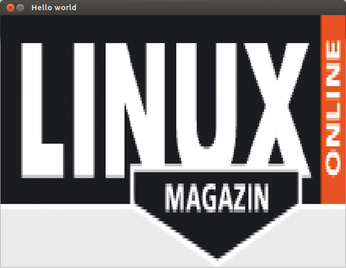Simple DirectMedia Layer 2.0
Great Artist
Next, the developer needs a renderer, that is, the tool that draws the window. How you do this is up to you. You could use DirectX in Windows, whereas you would normally use OpenGL on Linux. A renderer is generated by the SDL_CreateRenderer() function:
SDL_Renderer *renderer = SDL_CreateRenderer(window, -1,↩ SDL_RENDERER_ACCELERATED |SDL_RENDERER_PRESENTVSYNC);
As its first parameter, this command expects a pointer to the window into which the renderer will later dump all the output. The -1 flag tells SDL to select a renderer with specific properties. The following flags specify what they are. In the example, I want the renderer to use the graphics card's hardware acceleration (SDL_RENDERER_ACCELERATED) and synchronize the screen buildup with the screen frequency (SDL_RENDERER_PRESENTVSYNC). SDL_CreateRenderer() finally outputs a pointer to an appropriate renderer. If this pointer is NULL, an error occurred, and the reason is displayed by SDL_GetError().
You now can tell the renderer to empty the contents of the window:
SDL_SetRenderDrawColor(renderer, 235, 235, 235, 255); SDL_RenderClear(renderer);
The first function sets drawing color to a light gray with an RGB value of 235, 235, 235. The last parameter of SDL_SetRenderDrawColor() sets the transparency (more precisely, the value of the alpha channel). In this case, I want the renderer to make light gray opaque. SDL_RenderClear() then paints the window with the selected color.
Invitation
To display a picture in the window, you first need to load the picture. SDL itself only offers the SDL_LoadBMP() function, which loads an uncompressed BMP format image into memory. You only need to pass a file name to the function:
SDL_Surface *fig = SDL_LoadBMP("logo.bmp");As in the legacy SDL 1.2, the result is a pointer to a surface. This data structure simply encapsulates the bitmap in RAM. To load other formats, you need to either load them yourself and fire them into an SDL_Surface data structure or use a helper library, such as the popular SDL_Image (see the "Accomplices" box).
Accomplices
SDL covers only the game programmer's basic requirements with its function set. For example, it only loads images in BMP format. Because of this, some developers have written additional helper libraries: SDL_net simplifies access to the network, for example; SDL_mixer allows mixing of audio material; SDL_ttf embellishes text using TrueType fonts, and SDL_Image loads images in popular file formats.
These and several other libraries have even received the status of "official" extensions and found a home on the SDL website. Since the redesign of the home page, they are, however, no longer linked directly [3].
Together with SDL, the four above-mentioned libraries have made the jump to version 2. Essentially, they support the new features in SDL. For example, SDL_Image can return the image as a texture. The following statement loads a TIFF photo, logo.tiff, from disk:
SDL_Texture *logo = IMG_LoadTexture(renderer, "logo.tiff");
Because the libraries only work with SDL 2, they are now called SDL2_Image, SDL2_ttf, SDL2_mixer, and SDL2_net.
Converted
At this point, a small problem arises: The renderer can paint only textures in the window and not surfaces. This means you need to convert the surface into a texture:
SDL_Texture *texture = SDL_CreateTextureFromSurface(renderer, fig);
Because the surface is now redundant, the developer frees the memory allocated to it:
SDL_FreeSurface(fig);
Finally, you just need to tell the renderer to copy the texture into the window:
SDL_RenderCopy(renderer, texture, NULL,NULL);
The NULL in the penultimate parameter instructs the renderer to draw the entire texture in the window and not just a section. If the last parameter is NULL, the renderer fits the texture into the window. If the texture (i.e., the loaded image) has different dimensions from the window, it leads to distortion, as shown in Figure 3.

« Previous 1 2 3 4 Next »
Buy this article as PDF
(incl. VAT)
Buy Linux Magazine
Subscribe to our Linux Newsletters
Find Linux and Open Source Jobs
Subscribe to our ADMIN Newsletters
Support Our Work
Linux Magazine content is made possible with support from readers like you. Please consider contributing when you’ve found an article to be beneficial.

News
-
OSJH and LPI Release 2024 Open Source Pros Job Survey Results
See what open source professionals look for in a new role.
-
Proton 9.0-1 Released to Improve Gaming with Steam
The latest release of Proton 9 adds several improvements and fixes an issue that has been problematic for Linux users.
-
So Long Neofetch and Thanks for the Info
Today is a day that every Linux user who enjoys bragging about their system(s) will mourn, as Neofetch has come to an end.
-
Ubuntu 24.04 Comes with a “Flaw"
If you're thinking you might want to upgrade from your current Ubuntu release to the latest, there's something you might want to consider before doing so.
-
Canonical Releases Ubuntu 24.04
After a brief pause because of the XZ vulnerability, Ubuntu 24.04 is now available for install.
-
Linux Servers Targeted by Akira Ransomware
A group of bad actors who have already extorted $42 million have their sights set on the Linux platform.
-
TUXEDO Computers Unveils Linux Laptop Featuring AMD Ryzen CPU
This latest release is the first laptop to include the new CPU from Ryzen and Linux preinstalled.
-
XZ Gets the All-Clear
The back door xz vulnerability has been officially reverted for Fedora 40 and versions 38 and 39 were never affected.
-
Canonical Collaborates with Qualcomm on New Venture
This new joint effort is geared toward bringing Ubuntu and Ubuntu Core to Qualcomm-powered devices.
-
Kodi 21.0 Open-Source Entertainment Hub Released
After a year of development, the award-winning Kodi cross-platform, media center software is now available with many new additions and improvements.

